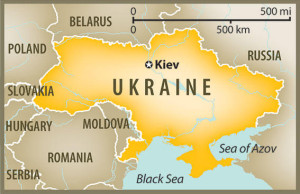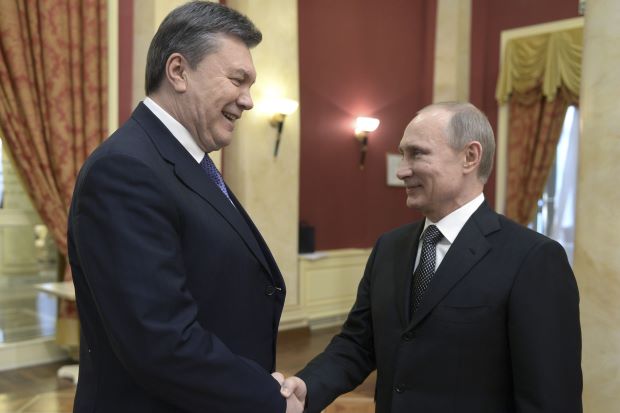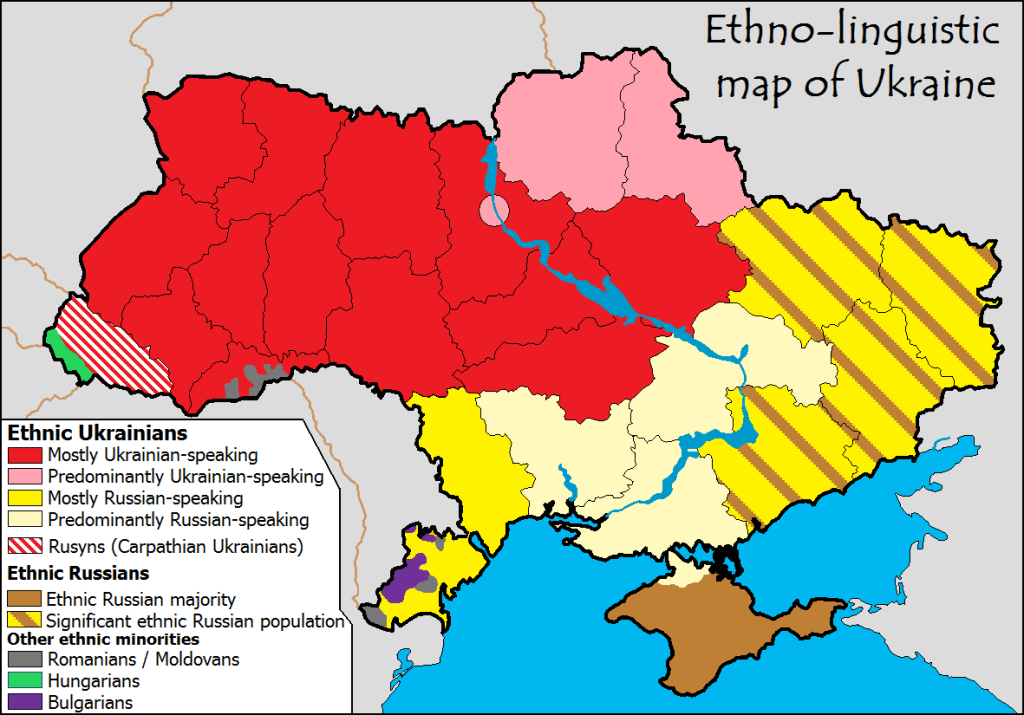redo Jump to...
print Print...
 (by David Blair, and Roland Oliphant in Kiev for London’s Daily Telegraph) — [Fierce fighting broke out Thursday between government forces and protesters in the Ukrainian capital, shattering a truce declared hours earlier and leaving scores of people dead.
(by David Blair, and Roland Oliphant in Kiev for London’s Daily Telegraph) — [Fierce fighting broke out Thursday between government forces and protesters in the Ukrainian capital, shattering a truce declared hours earlier and leaving scores of people dead.
A top human rights official said at least 50 people were killed in the clashes that erupted Thursday morning in the streets around Kiev’s Independence Square. Other estimates of the death toll were considerably higher.] The Telegraph saw ten corpses were laid out on the pavement beneath the awning of a cafe on the northern edge of Independence Square, where thousands of demonstrators are still camped. At least three of the bodies displayed single bullet wounds to the heads. A Reuters photographer counted a total of 21 bodies in three places on the square.
One demonstrator, who gave his name as Andreiy, carried in one body on a green military stretcher. “He died between 90 minutes and two hours ago,” he told a Telegraph reporter. “These are all live rounds. You can see what they do. He and all the others were shot in the head, the neck or the heart. None were shot anywhere else like in the legs.”
Andreiy blamed a “professional” government sniper, citing the accuracy of the shots, most of which were aimed at the head. The government has insisted that its forces have been acting with restraint. …
Hundreds of armed protesters bombarded police with Molotov cocktails and rocks, regaining control of most of the square they occupied at the start of the three-month political crisis. Demonstrators [also] appeared to have captured several uniformed officers.
Police responded with rubber bullets and stun grenades, although there were also reports of live rounds being used. It was unclear where the gunfire originated.
Officials were evacuated from Kiev’s main government building as the clashes continued.
In a statement published early on Thursday, before the latest fighting, the Ukrainian Health Ministry said 28 people had died and 287 had been hospitalized during the two days of street violence. Protesters, who have set up a medical care facility in a downtown cathedral, say the numbers are significantly higher.

Ukrainian President Viktor Yanukovich (left) shakes hands with Russian President Vladimir Putin prior to the 2014 Winter Olympic Games opening ceremony in Sochi, February 7, 2014. (photo: Reuters/Alexei Nikolsky/RIA Novosti)
The latest clashes have been the worst since protests kicked off three months ago after President Viktor Yanukovych shelved a [pending] agreement with the European Union in favor of closer ties with Russia. After Mr. Yanukovych shelved the agreement with the EU, Russia announced a $15 billion bailout for Ukraine, whose economy is in tatters.
The two sides are locked in a battle over the identity of this nation of 46 million, whose loyalties are divided between Russia and the West, and parts of the country are in open revolt against the central government.
The latest bout of street violence began on Tuesday when protesters attacked police lines and set fires outside parliament, accusing Mr Yanukovych of ignoring their demands to enact constitutional reforms that would limit the president’s power – a key opposition demand. Parliament, dominated by his supporters, was stalling on taking up a constitutional reform to limit presidential powers.
Police responded by attacking the protest camp. Armed with water cannons, stun grenades and rubber bullets, police dismantled some barricades. But the protesters held their ground through the night, encircling the protest camp with new burning barricades of tires, furniture and debris. …
Vitali Klitschko, the opposition leader who along with two others met with the president late on Wednesday to discuss a truce, said the president assured them that police would not storm the protesters’ encampment on Kiev’s Independence Square, according to the Interfax news agency.
A brief statement published on the president’s website late on Wednesday did not give details of what terms a truce would entail or how it would be implemented. Nor did it specify how the negotiations would be conducted or give an indication of how they would be different from previous meetings of the president and the opposition leaders.
[E.U. Commission President José Manuel Barroso expressed “shock and utter dismay” Wednesday over the “violence and use of excessive force,” which he blamed on Ukraine’s “political leadership.” He said he expects the E.U. to agree on “targeted measures against those responsible.” The Swedish foreign minister, Carl Bildt, said Yanukovych “has blood on his hands.”]Political and diplomatic manoeuvering has continued, with both Moscow and the West eager to gain influence over this former Soviet republic. Three EU foreign ministers – from Germany, France and Poland – were in Kiev on Thursday to speak with both sides before an emergency EU meeting in Brussels to consider sanctions against those responsible for the recent violence in Ukraine.
President Obama also stepped in to condemn the violence, warning on Wednesday “there will be consequences” for Ukraine if it continues. The U.S. has raised the prospect of joining with the EU to impose sanctions against Ukraine. “I want to be very clear as we work through these next several days in Ukraine that we’re going to be watching closely and we expect the Ukrainian government to show restraint, to not resort to violence in dealing with peaceful protesters,” Obama said. “We’ve also said we expect peaceful protesters to remain peaceful, and we’ll be monitoring very closely the situation, recognizing that with our European partners and the international community there will be consequences if people step over the line.”
On a visit to Mexico, Mr. Obama said the Ukrainian military should not step into a situation that civilians should resolve and added that the U.S. holds Ukraine’s government primarily responsible for dealing with peaceful protesters appropriately.
Russia’s Foreign Ministry, in turn, described the violence as an attempted coup and even used the phrase “brown revolution,” an allusion to the Nazi rise to power in Germany in 1933. The ministry said Russia would use “all our influence to restore peace and calm.”
A number of Ukrainian athletes left the Russian Black Sea resort of Sochi where they were competing in the Winter Olympics to return home amid the crisis, the International Olympic Committee said.
In Kiev, Ukraine’s top security agency accused on protesters Wednesday of seizing hundreds of firearms from its offices and announced a nationwide anti-terrorist operation to restore order. [If an “anti-terrorist” campaign begins, it is not clear what it will entail or how effectively it can be carried out. A special operation would presumably give the security service the authority to seize people and property without court orders for a specified period.]
Demonstrators, meanwhile, forced their way into the main post office on Kiev’s Independence Square, also known as the Maidan, after a nearby building they had previously occupied was burned down in fierce, fiery clashes late Tuesday with riot police. Thousands of activists armed with fire bombs and rocks had defended the square, a key symbol of the protests.
“The revolution has turned into a war with the authorities,” Vasyl Oleksenko, a retired geologist from central Ukraine, said Wednesday. “We must fight this bloody, criminal leadership. We must fight for our country, our Ukraine!”
Before the truce was announced the bad blood was running so high it has fueled fears the nation could be sliding toward a messy breakup. While most people in the country’s western regions resent Yanukovych, he enjoys strong support in the mostly Russian-speaking eastern and southern regions, where many want strong ties with Russia.
 Neither side had appeared willing to compromise, with the opposition insisting on Mr. Yanukovych’s resignation and an early election and the president apparently prepared to fight until the end. …
Neither side had appeared willing to compromise, with the opposition insisting on Mr. Yanukovych’s resignation and an early election and the president apparently prepared to fight until the end. …
Before the truce announcement, Mr. Yanukovych had blamed the protesters for the violence and said the opposition leaders had “crossed a line when they called people to arms.” …
In a joint statement, the three main opposition parties said they were not responsible for Tuesday’s deadly violence. “We have never called and never will call people to pick up arms,” it said. “This is our principled stance. The death of any person is a personal tragedy for each one of us.”
In Moscow, the Kremlin said it put the next disbursement of its bailout on hold amid uncertainty over Ukraine’s future and what it described as a “coup attempt.”
French Foreign Minister Laurent Fabius told reporters that he and his counterparts from Germany and Poland would meet both sides in Ukraine ahead of the EU meeting on possible sanctions. He said he hoped the two sides “will find a way for dialogue.”
Possible sanctions include travel bans and asset freezes, which could hit hard the powerful oligarchs who back Mr. Yanukovych.
Reprinted here for educational purposes only. From a Telegraph news report, with excerpts added from the Daily Mail article. May not be reproduced on other websites without permission from the Daily Telegraph.
Questions
1. a) Who is the president of Ukraine?
b) Which country backs the president?
2. On Thursday, at least 50 protesters were killed by government forces in Kiev’s Independence Square.
a) What accusation did a demonstrator make against the government in relation to the shootings?
b) What observation did the reporters make that implies they agree with the demonstrator?
3. The protests began three months ago. What do the protesters want?
4. What is the European Union (EU) response to the violence against the protesters?
5. How has President Obama responded? – What warning does he give to the Ukrainian president?
6. How does Russia portray the protesters? – What role will they play in Ukraine?
7. Why are Ukrainians split between support for their President and Russia, and support for the West?
Background
THE PROTESTS IN UKRAINE:
What began on November 21, 2013, as a Kiev- and western-Ukraine-based protest against the Yanukovych government’s decision to withdraw from the process of accession to the European Union and the regime’s decision to take an economic bailout from Putin’s Russia (which had been lobbying hard, and often viciously, against Ukraine’s EU aspirations) has transformed itself into a broad national movement for civil renewal: a transformation perhaps best described by Greek Catholic bishop Borys Gudziak on Vatican Radio as a transition from a “Euromaidan to a Maidan of dignity.” The issue is no longer “joining Europe,” in the narrow sense of gaining access to European markets, jobs, and consumer goods; the issue is “joining Europe” in the sense of joining a zone of law-governed democracies in which elementary civil liberties are respected and public affairs are conducted in a dignified manner, for the common good rather than personal gain. That morally driven form of “joining Europe” is an explicit rejection of the “managed democracy” of Putin’s Russia, which the Ukrainian reformers know to be a kleptocracy of oligarchs with a monopoly of political, economic, and media power, indulging fantasies of Great Russian imperialism while the society beneath them rots away with the worst public-health problems west of the Urals. (It is also, implicitly, a challenge to “Europe” to rediscover and reclaim the moral patrimony of the EU, whose founding fathers in the post–World War II period did not imagine it to be simply a set of mutually advantageous economic arrangements.)
The Maidan movement has also changed geographically and demographically. Once centered on western Ukraine and the capital of Kiev, the movement for civil renewal and reform has now established itself throughout the country, not without difficulty, but with considerable tenacity. Entrepreneurs and small-business owners are also more evident in the Maidan movement today than they were late last year.
What has not changed about the movement, and what is both impressive in itself and a potential weakness for the near future, is that the movement is completely self-organizing. There is no “power vertical,” and the movement follows no one political leader. There are three political-party leaders with international media visibility, but there is no Lech Walęsa [Poland] or Václav Havel [Czech Republic] on the horizon in Ukraine at the moment.
Those who have stayed for nearly three months in the Maidan’s encampments in central Kiev, and those who have established similar resistance centers in other Ukrainian cities, have withstood freezing weather and regime brutality by means of self-organized self-defense. At one of the chief Maidan posts in Kiev, on Hrushevskoho Street, a defensive perimeter has been organized by a Jewish Ukrainian with counterterrorism experience in the Israeli Defense Forces. Other Ukrainian veterans of either the old Red Army or the post-1991 Ukrainian military have put themselves in harm’s way again to offer similar expertise. And while these efforts have been keeping the brutal Ukrainian special forces and their hired hooligans at bay for some weeks now, other Maidan leaders have organized meals, housing (in tents), and medical care for the reformers (who stopped going to local hospitals after wounded activists were kidnapped there by the regime, with some later found dead in the woods). (from nationalreview.com)
Ethnolinguistic Map of Ukraine:

Daily “Answers” emails are provided for Daily News Articles, Tuesday’s World Events and Friday’s News Quiz.



